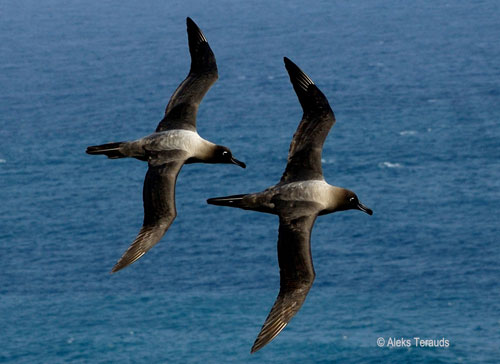Field workers on Australia's sub-Antarctic Macquarie Island have come across two Light-mantled Sooty Albatrosses Phoebetria palpebrata that were banded in 1971 as adults, so they are estimated to be at least 45 years old. The news comes from yesterday's issue of the electronic newsletter from the island "This week at Macquarie Island" (click here).

Two Light-mantled Sooty Albatrosses fly in unison. Photograph by Aleks Terauds
"The albatross researchers, Anna and Jaimie, have returned from the southern reaches of Macquarie Island brandishing gold! Albatross gold. The diet of several seabird species, including Macquarie Island's four species of albatross, is being investigated by seabird ecologists at the Australian Antarctic Division. This is achieved by analysing the DNA of prey species found in the faeces of the albatross. Being a part of a large scale diet analysis of Antarctic and sub-Antarctic species has got Macca's Alby researchers very excited and they have been working extremely hard to unlock the secrets of the albatross through their poo! Unfortunately their quest for gold often leaves them covered in it.
This week, Anna and Jaimie have been working their way around the island spending much of their time looking at the breeding of light-mantled albatross. Exciting news has come with two sooties (as they are affectionately known) found in Gadgets Gully that were banded in 1971 as adults, making them at least 45 years old! At the southern end of the island a black-browed albatross was found with a band that has come from the Museum of Paris, most likely banded on Iles Kerguelen. The band information has been sent to the museum to confirm the bird's origin. We eagerly await a reply. This is the second French black-brow recorded breeding on Macquarie Island. With the help of MIPEP [Macquarie Island Pest Eradication Project] hunters, three grey-headed albatross have been found nesting in two new locations: Cape Star and Caroline Point. This could be due to better nesting habitat in these areas or expansion of the main breeding colony." (click here).
John Cooper, ACAP Information Officer, 24 November 2012

 English
English  Français
Français  Español
Español